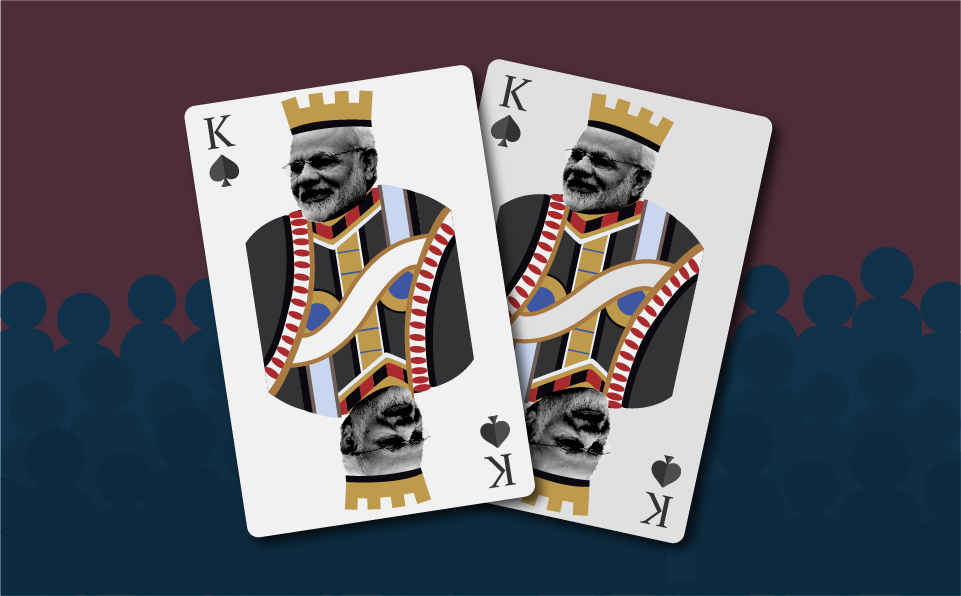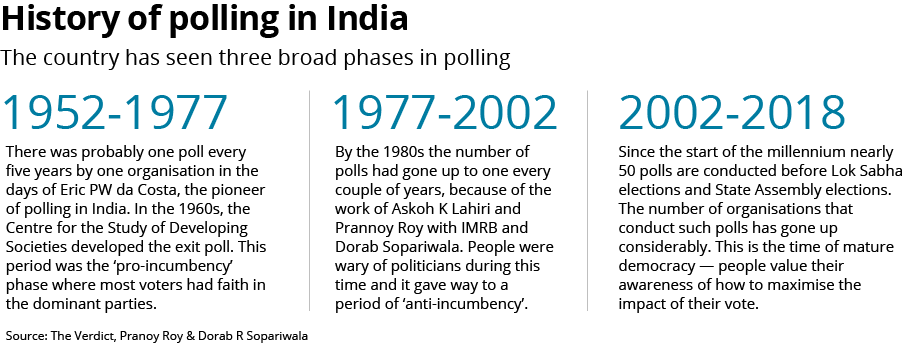
- Home
- News
- Analysis
- States
- Perspective
- Videos
- Education
- Entertainment
- Elections
- World Cup 2023
- Features
- Health
- Business
- Series
- Economy Series
- Earth Day
- Kashmir’s Frozen Turbulence
- India@75
- The legend of Ramjanmabhoomi
- Liberalisation@30
- How to tame a dragon
- Celebrating biodiversity
- Farm Matters
- 50 days of solitude
- Bringing Migrants Home
- Budget 2020
- Jharkhand Votes
- The Federal Investigates
- The Federal Impact
- Vanishing Sand
- Gandhi @ 150
- Andhra Today
- Field report
- Operation Gulmarg
- Pandemic @1 Mn in India
- The Federal Year-End
- The Zero Year
- Premium
- Science
- Brand studio
- Home
- NewsNews
- Analysis
- StatesStates
- PerspectivePerspective
- VideosVideos
- Entertainment
- ElectionsElections
- Sports
- Loading...
Sports - Features
- BusinessBusiness
- Premium
- Loading...
Premium

Exit polls confound, crown Modi king
Unlike opinion polls, which are conducted after the last ballot has been cast and before the counting of votes, exit polls are done on election day outside the polling station.

Exit poll results released on May 19 are as confounding as the election itself has been. An incumbent is being pronounced the winner but with a bigger majority, trumping key electoral considerations like caste. Only one agency predicted that the BJP-led NDA will not gain a majority but would still be close to it. Types of opinion polls in India Pre-polls: Fieldworkers gather data from...
Exit poll results released on May 19 are as confounding as the election itself has been. An incumbent is being pronounced the winner but with a bigger majority, trumping key electoral considerations like caste. Only one agency predicted that the BJP-led NDA will not gain a majority but would still be close to it.
- Types of opinion polls in India
-
- Pre-polls: Fieldworkers gather data from people on the voters list about who they’ll vote for and why.
- House-to-house opinion polls: Fieldworkers go from house to house questioning voters. This is for a small sample size.
- Street-corner opinion polls: Fieldworkers question voters at street corners. These are easy and cheap to conduct, and there’s a large sample size.
- Exit polls: Fieldworkers stand outside polling stations and ask voters who they voted for once they are inked. This method is typically the most accurate.
- Post-polls: Post-polls are conducted after the last ballot has been cast and before the counting of votes.
- Insta polls: This is a type of exit polling but answers are sent back to telecom networks instantly. As a result how people have voted is known minute-by-minute in real-time. Only one such poll has been conducted in India.
- Social media polls: Various social media platforms ask people for their preferences to gather data. These polls can be very misleading.
Source: The Verdict, Pranoy Roy & Dorab R Sopariwala
-
Most of the surveying agencies predicted fewer seats for the NDA in their opinion polls done a few months ago. This means the ruling party has actually gained ground as the election progressed. Typically, it’s the opposition that gains as campaign progresses but if the ruling party has indeed gained ground, it may well be a reflection on the BJP’s campaign strategies.
The predictions vary widely – from 245 to 368 seats for the NDA across India. In UP, the variance is most pronounced. The lowest was 22 out of 80 seats and the highest was 68 in Uttar Pradesh. The prediction beats most assumptions about the UP, which was that the SP-BSP alliance is formidable because of the caste arithmetic. Television channels did not mention that the exit polls couldn’t have covered phase 7 which included 13 UP seats.
At least half a dozen exit poll results were released. News18-IPSOS claims to have conducted surveys in 199 out of 543 parliamentary constituencies and surveyed over 1.2 lakh voters. They are said to have selected 796 Assembly segments and interviewed 25 voters each in 4,776 individual polling stations. They gave a high of over 336 seats to the NDA. In past exit polls, too, questions have been raised about how representative the chosen constituencies can be.
Times Now, which predicted 249 for NDA, 148 for the UPA and 146 for others in 2014, increased its numbers for the Modi-led government to 306 and lowered it for the Congress-led side to 132 seats and others to 104. Several state governments are likely to topple, like Karnataka, Rajasthan and Madhya Pradesh, according to most polls.
What went wrong when exit polls failed
For pollsters, the trauma of the 2004 Lok Sabha elections hasn’t vanished completely, when exit polls predicted a massive victory for the BJP. If the exit polls were to be believed, the BJP-led NDA should have won anything between 230-275 of the 543 seats. But when the results were announced the nation was shocked — the NDA won just 189 seats. The Congress-led UPA won 222 seats. It managed to form the government with the help of the Bahujan Samaj Party, Samajwadi Party, the Left parties and a few regional parties.
In 2015, exit polls expected the BJP to see another mega sweep in Bihar’s Assembly election after the Modi ‘wave’ in 2014. Various exit polls gave clear lead to the BJP — News 24-Chanakya, which has a high accuracy rate, gave the BJP a tally of 155 in the 243-seat house. NDTV and India Today’s numbers were close to 120 seats for the BJP. When the results were announced, the exit poll numbers were, once again, incorrect. The BJP suffered a major defeat and the Nitish Kumar-led grand alliance bagged 178 seats.
Are exit polls reliable?
In their book ‘The Verdict – Decoding India’s Elections’ Prannoy Roy and Dorab R Sopariwala have dedicated a chapter to the question ‘Can you trust opinion polls in India?’. According to them, opinion polls globally tend to be less accurate than exit polls. In fact, they say exit polls are quite reliable — 97 per cent of exit polls (excluding 2004) during Lok Sabha elections predict the correct winner. The number is slightly lower for State Assembly elections — 82 per cent.
However, the book says polls underestimate the winner’s seats in all polls (Lok Sabha and State Assembly exit and opinion polls) by 17 per cent. It says 82 per cent of exit polls underestimate the seats of the winner during the general elections, while 73 per cent for Assembly elections. The percentage of extent by which polls underestimate the winner’s seat is considerably 14 per cent during general elections and 15 per cent during State elections.
This means that while exit polls are accurate and reliable, they underestimate the winner’s seat share and are conservative in their estimates. An example of this is the 2015 Delhi elections. Although most exit polls indicated that the Aam Aadmi party would win the Assembly elections, none of them saw the party getting 67 seats in the 70-member Delhi Assembly. All exit polls gave the AAP a clear majority, but only one had tipped their tally over 50 seats.

Exit vs opinion polls
Roy and Sopariwala point to multiple causality for why exit polls are better than opinion polls. Firstly, the voter turnout is one of the most difficult variables to forecast, according to them. Secondly, exit polls reflect the views of actual voters who have turned up and are just coming out of polling booths. In any election the key ‘floating’ voters (swing voters) often change their mind several times in the run up to the elections and, hence, it is only by taking their view on election day can one measure accurately how they have cast their votes.
Exit polls, unlike descriptive opinion polls, also benefit from a large sample size, allowing them to have a larger confidence interval (smaller error margin). Large sample size is possible because voters are easy to access on polling day as the movement of voters to the polling booth and back is easier to track. While an opinion poll often involves going from a voters house to another as a part of a stratified random sample, exit polls require much less travel and less expense and the format is designed for quick and easy access to voters.
What one needs to remember is that all these surveys have some margin of error. Thus, an exit poll may be an indicator of a major trend but is not the final result.

